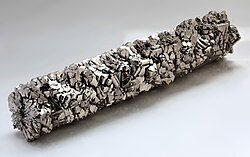Titanium (chemical symbol – Ti, from Latin Titanium) is a chemical element of the 14th group (formerly classified as a subgroup of the fourth group, IVB) of the fourth period of the periodic table of chemical elements by D. I. Mendeleev, with an atomic number of 22.
Group of metals: Refractory lightweight metal
Atomic number: 22
Atomic mass: 47.867
Melting point: 1670°C (1943 K)
Density: 4.54 g/cm³
Density at 20°C: 4.505 g/cm³
Boiling point: 1668°C (3560 K)
Heat of fusion: 18.8 kJ/mol
Latent heat of fusion: 358 J/g
Heat of vaporization: 422.6 kJ/mol
Latent heat of vaporization: 8.97 kJ/g
Thermal conductivity (300 K): 21.9 W/(m·K)
Molar volume: 10.6 cm³/mol
Specific heat capacity at 20°C: 0.54 kJ/(kg·°C)
Specific thermal conductivity at 20°C: 18.85 W/(m·K)
Specific electrical resistivity at 20°C: 8.15 × 10⁻⁶ ohm·cm
Specific electrical conductivity at 20°C: 2.38 × 10⁻⁶ S/cm
Young’s Modulus: 112 GPa
Poisson’s Ratio: 0.32
Hardness: 130…150 HV
Spark color: Bright white long intense spark stream
Titanium is one of the most abundant elements in the Earth’s crust, ranking 9th in abundance. Its content in the Earth’s crust is approximately 0.57% by mass, and in seawater, it’s about 0.001 mg/L.
Natural titanium resources exceed those of copper, zinc, lead, silver, chromium, and others.
Titanium-containing compounds in nature are very common:
- In sedimentary rocks: about 0.04% in limestone and 0.15% in sandstone.
- In clay rocks and shales: 0.39%.
- In oceanic basalts: 1.2% and plateau basalts: 1.5%.
- In granites: 0.23%.
For industrial processing, formations with high titanium concentrations are used. The primary titanium ore is ilmenite, which contains up to 36% titanium, and the richest titanium ore is rutile, which contains up to 60% Ti.
In industry, Ti is obtained using efficient methods
- Magnesium thermal reduction: involves extracting ore containing Ti and processing it into dioxide under the influence of high temperatures and chlorination in a carbon environment. The resulting Ti chloride is then reduced with magnesium. The next step is heating the metal in a vacuum furnace at high temperatures, resulting in the evaporation of magnesium and magnesium chloride, leaving behind a sponge-like metal with numerous pores that is then remelted.
- Hydride-calcium method: initially, titanium hydride is obtained, which is then separated into Ti and H2. The procedure is carried out in the absence of air and at high temperatures. Calcium oxide is formed and washed using weak acids.
- Electrolytic method: titanium chloride or titanium dioxide undergo the influence of a powerful current. The result of the process is the decomposition of compounds.
- Iodide method: titanium dioxide reacts with iodine vapors. Then, to obtain the metal, titanium iodide is subjected to high temperatures. This is the most effective and expensive method. The resulting metal is of high quality and free from impurities and additional elements.
The strength of technically pure titanium depends on the purity of the metal. Impurities of carbon, oxygen, and hydrogen decrease its plasticity, corrosion resistance, and weldability. Hydrogen impurities, in particular, are harmful. Titanium is used to manufacture rolled and pressed pipes, sheets, wire, forgings. It has good weldability, high mechanical properties, corrosion resistance, and heat resistance, but it is difficult to cut and has low frictional properties.
Titanium Alloys
The advantage of Ti alloys over pure titanium lies in their higher strength and heat resistance with good plasticity, high corrosion resistance, and low density.
By technological purpose, they are divided into cast and deformable.
By strength, Ti alloys are divided into three groups:
- Low-strength with σ_b = 300…700 MPa (VT1);
- Medium-strength with σ_b = 700…1000 MPa (VT3, VT4, VT5);
- High-strength with σ_b > 1000 MPa (VT6, VT14, VT15) after quenching and aging.
Ti alloys are used in various industries:
- Aerospace and rocket manufacturing: structural parts, cladding, fuel tanks, components of rocket engines, disks and blades of compressors, air intake parts, components of second and third-stage rocket engines, and more.
- Shipbuilding: hull cladding for ships and submarines, welded pipes, propellers, impellers, pump parts, and more.
- Chemical industry: reactors for aggressive environments, pumps, coils, centrifuges, and more.
- Electroplating: baths for chromium plating, anode baskets, heat exchangers, pipelines, hangers,
